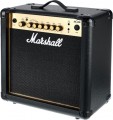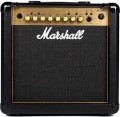Number of channels
The number of channels provided in a combo amplifier or a separate “head” (see “Type”).
This parameter is specified only if the device has
more than one channel. The channel in this case can be described as a kind of “path” for the audio signal, which has its own specific set of settings. If there are several such “paths,” then each of them can be configured at your discretion and you can switch between sound options with just one click of a button (in extreme cases, by switching the instrument to another input). The most typical example of using this function looks like this: one channel is used for clean sound, and the second is used for “overdrive” using the built-in distortion or overdrive (see “Effects”). Without channel separation, the sound would have to be changed either by reconfiguring the amplifier (setting the parameters again each time, which is simply inconvenient), or by using external “gadgets” (and this is not always the best option for a number of other reasons).
As for the number of channels, in multi-channel models there are most often just two of them - this gives the mentioned additional capabilities and at the same time does not particularly affect the cost of the device. This option is optimal for beginning musicians, but is also found in professional equipment. Increasing the number of channels makes it possible to provide more advanced options for preset settings (for example, “clean ringing”
..., “clean warm”, “Crunch” and “Overdrive”), but it significantly complicates and increases the cost of the design. Therefore, the higher this number, the fewer models with such characteristics are presented on the market. The maximum value found in modern guitar amplifiers is 6; a similar amount can be found in individual professional models, mainly with a digital element base (see “Type”).Digital effects block
The presence of a block of digital effects in the amplifier. Note that this function can be provided in any models, not only digital ones (see "Type").
As the name implies, this function allows you to change the sound in one way or another, sometimes quite drastically. See below for the most popular effects; their specific set may be different, it should be specified separately in each model. Here we note that without this function, additional external “gadgets” will be required to work with effects.
Effects
Built-in effects provided in the combo amplifier. You can also achieve various effects with the help of external “gadgets”, however, such gadgets need to be searched for and connected separately, while built-in effects are available immediately and without unnecessary settings.
—
Overdrive. Distortion in the form of a characteristic electric guitar "buzz" at low frequencies and "howl" at high frequencies, a little softer than distortion. Popular, in particular, in hard rock.
—
Distortion. Sufficiently hard and sharp distortion, similar in sound to overdrive, but more intense and brighter. It is widely used in various styles of metal, and is also found in rock.
—
Reverb. An effect based on simulating multiple decaying echoes from each sound. Depending on the duration and intensity of repetitions, it can give the sound a different colour. Used as an artistic device; among other things, it can create the effect that the guitar sounds in a certain room (concert hall, room with stone walls, an open area in the mountains, etc.). Note that the reverberation can be adjusted both by individual parameters (intensity, echo duration, etc.), and by selecting a preset set of parameters (for example, “sharp sound in the room” or “soft sound in the hall”).
—
Tremolo. Tremolo is basically a trembling effect that res
...ults from small and quick fluctuations in the volume of each note. Sometimes this term means vibrato (see below) — to the point that the manufacturers of guitar amplifiers themselves mean the effect of vibrato by the tremolo effect, and vice versa. So the specifics of this effect in each case should be clarified separately. Anyway, the tremolo can be "fixed" or adjustable in depth (range of volume change) and speed (jitter frequency).
— Vibrato. Another effect of "jerking" sound, which is often confused with tremolo (see above) — to the point that both these terms are used as identical. However, this is not true; the difference lies in the fact that vibrato is carried out due to the rapid fluctuations of the note not in volume, but in frequency. A similar effect can be achieved on the guitar itself by "pulsating" the strings, but using the amplifier's built-in instrument is much more convenient in most cases.
— Chorus. An effect designed to simulate the choral sound of an instrument. To do this, the amplifier copies the sound of the guitar and plays several copies simultaneously with the original signal, slightly shifting them in time (about 20 – 30 ms with a constant change) and frequency. However it is impossible to achieve a full-fledged choral sound in this way, but the effect is quite original in itself.
— Delay. A specific type of reverb (see "Reverb") that has become widespread as a separate effect. Delay simulates a clear single echo from the sound being played; for this, the original signal is copied and reproduced with a certain time delay (at least 50 ms).
In addition to those described above, other effects can be found in modern guitar combo amplifiers, in particular:
— Flanger. The effect is reminiscent of the whistle of a jet engine; it is often compared to a plane taking off. It is created similarly to the Chorus described above, differs from it in a shorter delay time and the presence of feedback.
— echo. Another kind of reverb, similar to delay (see “Delay”). It differs in that in this case the echo is reproduced repeatedly.
— Octaver. An effect in which a copy of it is added to the signal, shifted by an octave or two.
— Wah wah. An effect that produces a characteristic "croak" sound.
